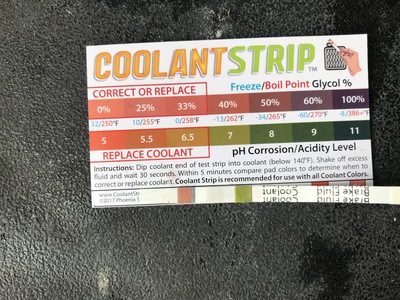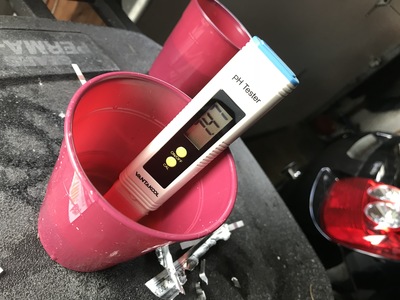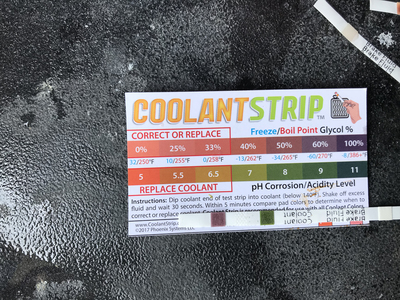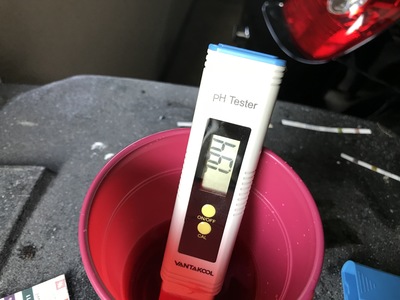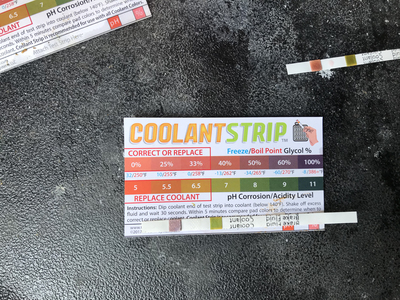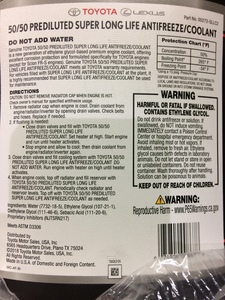I've heard good things about Norwalk but I never used them. Might have to now, the MR2 is officially going on jackstands for a while.
2000 Toyota MR2 Spyder, 2021 Lexus UX 250h F Sport
Toyota like other manufacturers do at times make backwards compatible fluids and filters to streamline their inventory but it is not always what is best for your old Toyota. They keep the red concentrate around because the pink doesn’t work well with some of the older Toyota coolant components because of the formulation of the newer organic technology has been known to cause issues with seals. Sometimes the trade off is not worth it and the formulations that the car was tested with is usually the best option. I have also heard that the red although half the life of pink seems to be trouble free and known to last much longer than it’s recommended change interval after it was tested.
Do you know if the red and pink can be mixed at all?
I've heard good things about Norwalk but I never used them. Might have to now, the MR2 is officially going on jackstands for a while.
Oh no! What happened?
I’m mindful of going off topic and messing up what Paul is trying to set up here so l’ll go back and delete this entry later.
Off topic when it's slightly relevant is not a problem I'd think, as long as the question of the topic continues. I'll post a "build thread" type doohickey soon with the new issues.
2000 Toyota MR2 Spyder, 2021 Lexus UX 250h F Sport
Toyota like other manufacturers do at times make backwards compatible fluids and filters to streamline their inventory but it is not always what is best for your old Toyota. They keep the red concentrate around because the pink doesn’t work well with some of the older Toyota coolant components because of the formulation of the newer organic technology has been known to cause issues with seals. Sometimes the trade off is not worth it and the formulations that the car was tested with is usually the best option. I have also heard that the red although half the life of pink seems to be trouble free and known to last much longer than it’s recommended change interval after it was tested.
Do you know if the red and pink can be mixed at all?
It can without any issues however if you mix them then the coolant will be downgraded from a super long life to a long life coolant and will have to follow the shorter change intervals.
If did some research and found a TSB where they state that after 2002 (I assume for the 2003 build) the Spyder along with a few other Toyota models were supplied with the pink.
The problem comes from older vehicles that use some brass components in the coolant system and it is believed that the aluminum blocks can handle the pink but not the other way around.
The problem comes with a lot of hearsay about the pink not being as good as the red in regard to its stated longevity and that it deteriorates the seals particularly the water pump. It's not enough to be alarming because these issues generally fall into a timeline where the car has already accumulated high miles where water pump replacement is normal.
What Im going to say now is purely anecdotal speculation from what I have seen in person and what I have read on the forums and that is I have in person seen higher incidence of water pump replacement or coolant leaks in three facelift Spyders that were fitted with the pink. I don't think its going to happen with all face lift cars that run the pink but its enough for me to stick with the Red. I believe that the Super long life chemistry is more acidic and it can lead to premature wear of the rubber seals or possibly causing corrosion over a very long period of time. For most people with Corollas and Camrys its probably not going to be an issue unless you intend to keep your car well beyond 150k miles and it might only require a water pump. The red on the other hand is legendary for going well past Its interval as many older Toyotas never got a coolant change due to poor maintenance from those that are running these cars into the ground, and remarkably did not have a coolant related failure.
There is probably nothing at all wrong with the pink as its probably just as good as any of the other manufactures coolant but there is certainly something very unique and special about the red.
Toyota like other manufacturers do at times make backwards compatible fluids and filters to streamline their inventory but it is not always what is best for your old Toyota. They keep the red concentrate around because the pink doesn’t work well with some of the older Toyota coolant components because of the formulation of the newer organic technology has been known to cause issues with seals. Sometimes the trade off is not worth it and the formulations that the car was tested with is usually the best option. I have also heard that the red although half the life of pink seems to be trouble free and known to last much longer than it’s recommended change interval after it was tested.
Do you know if the red and pink can be mixed at all?
It can without any issues however if you mix them then the coolant will be downgraded from a super long life to a long life coolant and will have to follow the shorter change intervals.
If did some research and found a TSB where they state that after 2002 (I assume for the 2003 build) the Spyder along with a few other Toyota models were supplied with the pink.
The problem comes from older vehicles that use some brass components in the coolant system and it is believed that the aluminum blocks can handle the pink but not the other way around.
The problem comes with a lot of hearsay about the pink not being as good as the red in regard to its stated longevity and that it deteriorates the seals particularly the water pump. It's not enough to be alarming because these issues generally fall into a timeline where the car has already accumulated high miles where water pump replacement is normal.
What Im going to say now is purely anecdotal speculation from what I have seen in person and what I have read on the forums and that is I have in person seen higher incidence of water pump replacement or coolant leaks in three facelift Spyders that were fitted with the pink. I don't think its going to happen with all face lift cars that run the pink but its enough for me to stick with the Red. I believe that the Super long life chemistry is more acidic and it can lead to premature wear of the rubber seals or possibly causing corrosion over a very long period of time. For most people with Corollas and Camrys its probably not going to be an issue unless you intend to keep your car well beyond 150k miles and it might only require a water pump. The red on the other hand is legendary for going well past Its interval as many older Toyotas never got a coolant change due to poor maintenance from those that are running these cars into the ground, and remarkably did not have a coolant related failure.
There is probably nothing at all wrong with the pink as its probably just as good as any of the other manufactures coolant but there is certainly something very unique and special about the red.
Wasn’t sure if my 03’s and 05 had the red or pink so last night i pulled a little out of each reservoir and put into glass containers. At first glance, I thought the 05 had the red in it. One glass jar had new pink stuff in it and comparing that with the other 3glass jars, i still cannot conclude what fluid was put in there. I guess it looks more red than the pink stuff. Hard to tell what heat and time will do to the color. According to what you’ve said, my cars should have the pink?? Any thoughts, anyone?
Oh, and the 05 has the leaky water pump at 62k miles whereas the 03’s have no issues at 111 & 78k miles.
Toyota like other manufacturers do at times make backwards compatible fluids and filters to streamline their inventory but it is not always what is best for your old Toyota. They keep the red concentrate around because the pink doesn’t work well with some of the older Toyota coolant components because of the formulation of the newer organic technology has been known to cause issues with seals. Sometimes the trade off is not worth it and the formulations that the car was tested with is usually the best option. I have also heard that the red although half the life of pink seems to be trouble free and known to last much longer than it’s recommended change interval after it was tested.
Do you know if the red and pink can be mixed at all?
It can without any issues however if you mix them then the coolant will be downgraded from a super long life to a long life coolant and will have to follow the shorter change intervals.
If did some research and found a TSB where they state that after 2002 (I assume for the 2003 build) the Spyder along with a few other Toyota models were supplied with the pink.
The problem comes from older vehicles that use some brass components in the coolant system and it is believed that the aluminum blocks can handle the pink but not the other way around.
The problem comes with a lot of hearsay about the pink not being as good as the red in regard to its stated longevity and that it deteriorates the seals particularly the water pump. It's not enough to be alarming because these issues generally fall into a timeline where the car has already accumulated high miles where water pump replacement is normal.
What Im going to say now is purely anecdotal speculation from what I have seen in person and what I have read on the forums and that is I have in person seen higher incidence of water pump replacement or coolant leaks in three facelift Spyders that were fitted with the pink. I don't think its going to happen with all face lift cars that run the pink but its enough for me to stick with the Red. I believe that the Super long life chemistry is more acidic and it can lead to premature wear of the rubber seals or possibly causing corrosion over a very long period of time. For most people with Corollas and Camrys its probably not going to be an issue unless you intend to keep your car well beyond 150k miles and it might only require a water pump. The red on the other hand is legendary for going well past Its interval as many older Toyotas never got a coolant change due to poor maintenance from those that are running these cars into the ground, and remarkably did not have a coolant related failure.
There is probably nothing at all wrong with the pink as its probably just as good as any of the other manufactures coolant but there is certainly something very unique and special about the red.
Wasn’t sure if my 03’s and 05 had the red or pink so last night i pulled a little out of each reservoir and put into glass containers. At first glance, I thought the 05 had the red in it. One glass jar had new pink stuff in it and comparing that with the other 3glass jars, i still cannot conclude what fluid was put in there. I guess it looks more red than the pink stuff. Hard to tell what heat and time will do to the color. According to what you’ve said, my cars should have the pink?? Any thoughts, anyone?
The problem is once you dilute the red it becomes a lighter shade of red and very close to the pink.
There is possibly one way to tell which I have actually tested. The Red is far more basic and the pink is acidic for both new and old coolant and don’t very that much with age as long as it’s within the interval. I have tested between new and old pink and red using a digital ph tester and coolant strip testers.
I have also found that the PH strips would read the new and old pink close to being bad when it’s not the case probably because the strips are meant for inorganic coolant.
Let me see if I still have the pictures of my test.
Edit: I found the pictures. I will post them tomorrow. I have a bad case of CTS.
The Zerex Asian is definitely a more shocking pink than the diluted red I run in my Corolla. It's still pretty blood red to me.
2000 Toyota MR2 Spyder, 2021 Lexus UX 250h F Sport
Toyota like other manufacturers do at times make backwards compatible fluids and filters to streamline their inventory but it is not always what is best for your old Toyota. They keep the red concentrate around because the pink doesn’t work well with some of the older Toyota coolant components because of the formulation of the newer organic technology has been known to cause issues with seals. Sometimes the trade off is not worth it and the formulations that the car was tested with is usually the best option. I have also heard that the red although half the life of pink seems to be trouble free and known to last much longer than it’s recommended change interval after it was tested.
Do you know if the red and pink can be mixed at all?
It can without any issues however if you mix them then the coolant will be downgraded from a super long life to a long life coolant and will have to follow the shorter change intervals.
If did some research and found a TSB where they state that after 2002 (I assume for the 2003 build) the Spyder along with a few other Toyota models were supplied with the pink.
The problem comes from older vehicles that use some brass components in the coolant system and it is believed that the aluminum blocks can handle the pink but not the other way around.
The problem comes with a lot of hearsay about the pink not being as good as the red in regard to its stated longevity and that it deteriorates the seals particularly the water pump. It's not enough to be alarming because these issues generally fall into a timeline where the car has already accumulated high miles where water pump replacement is normal.
What Im going to say now is purely anecdotal speculation from what I have seen in person and what I have read on the forums and that is I have in person seen higher incidence of water pump replacement or coolant leaks in three facelift Spyders that were fitted with the pink. I don't think its going to happen with all face lift cars that run the pink but its enough for me to stick with the Red. I believe that the Super long life chemistry is more acidic and it can lead to premature wear of the rubber seals or possibly causing corrosion over a very long period of time. For most people with Corollas and Camrys its probably not going to be an issue unless you intend to keep your car well beyond 150k miles and it might only require a water pump. The red on the other hand is legendary for going well past Its interval as many older Toyotas never got a coolant change due to poor maintenance from those that are running these cars into the ground, and remarkably did not have a coolant related failure.
There is probably nothing at all wrong with the pink as its probably just as good as any of the other manufactures coolant but there is certainly something very unique and special about the red.
Wasn’t sure if my 03’s and 05 had the red or pink so last night i pulled a little out of each reservoir and put into glass containers. At first glance, I thought the 05 had the red in it. One glass jar had new pink stuff in it and comparing that with the other 3glass jars, i still cannot conclude what fluid was put in there. I guess it looks more red than the pink stuff. Hard to tell what heat and time will do to the color. According to what you’ve said, my cars should have the pink?? Any thoughts, anyone?
The problem is once you dilute the red it becomes a lighter shade of red and very close to the pink.
There is possibly one way to tell which I have actually tested. The Red is far more basic and the pink is acidic for both new and old coolant and don’t very that much with age as long as it’s within the interval. I have tested between new and old pink and red using a digital ph tester and coolant strip testers.
I have also found that the PH strips would read the new and old pink close to being bad when it’s not the case probably because the strips are meant for inorganic coolant.
Let me see if I still have the pictures of my test.
Edit: I found the pictures. I will post them tomorrow. I have a bad case of CTS.
Great idea!
I tested all 4 jars and they’re all about 8-8.5 so about neutral. Does that mean it’s the pink since one of the jars is new pink?
wow! Did we go off on a tangent? This should be a thread on antifreeze, lol.
I don't think we went so far off because we are seeing if there are alternatives. I wouldn't have minded buying Zerex coolant as it has a great reputation but there is something about the red coolant that is extra ordinary and legendary.
I did this testing a few years ago. The digital PH tester for some reason wasn't accurate between new and old coolant. Also keep in mind that I should have shot this with my SLR using a color checker as the intensity and shade are slightly off from what I tested.
First up is my Spyder with the red coolant. It has been in my car since 2009. Don't judge me as I don't have many miles and decided not to change it but I got worried because of age so I tested the coolant.
The reason why you see the dilution as 35% was done on purpose because I don't drive my car in freezing weather so decided to run more water and water wetter as a surfactant. The condition of the coolant was very clean. Instead of doing a full flush and jinks my bubble free coolant system I decided to instead remove and replenish until I get unto 50% coolant and test again.
As a control here is full strength Toyota Red.
Keep in mind that I should have done a control with a 50/50 mixture as full strength is probably more basic.
It would seem I lost the digital reading of the pink and the new pink strip test. Regardless the digital PH tester was very inaccurate for other things besides coolant so I don't put much faith in it.
I only have old pink test strip for a car that has 6 years on the coolant and 40k miles.
If I had a larger sampling size we could draw conclusion but there are many variables that invalidate my test regarding the pink. It would seem you cant judge the newer organic acid coolant with the test strips because they will read more acidic then the inorganic.
One thing to note which I have read that is hearsay and that is coolant change intervals are generally done much sooner for the most extreme cases as a rule of thumb not necessarily because they have to be changed on that interval of going bad. Age can make the coolant system go bad but its the millage that expires coolant quicker.
As far as red vs pink, Im sticking with the red because its proven to be amazing coolant even when being abused. The Toyota truck enthusiasts who log many miles believe the red keeps their original cooling components from corroding after many hundreds of thousands of miles. Mechanics that see these vehicles also commented that the red has incredible service life and are not as thrilled with the pink but in its defense its not a bad coolant. A lot of this could just be BS because people like to hang on to legacy fluids. For me there is no reason to "upgrade" to pink because it hasn't demonstrated any superior formulation in regards to better protection of my coolant components.
I like this type of experimenting; it gives us something objective to go by.
It looks like all my car's coolant is good by your chart. I usually only change the coolant whenever something needs replacing, water pump, thermostat, etc.
Sounds like the red is a good choice and seems to be cheaper but i had already purchased the pink, thinking this was the original coolant and wouldn't have to change it for a long time.
Kind of odd, the bottle says to use on any toyota except the FRS engine. Why do you suppose that is? Does the red say that too?
I like this type of experimenting; it gives us something objective to go by.
It looks like all my car's coolant is good by your chart. I usually only change the coolant whenever something needs replacing, water pump, thermostat, etc.
Sounds like the red is a good choice and seems to be cheaper but i had already purchased the pink, thinking this was the original coolant and wouldn't have to change it for a long time.
Kind of odd, the bottle says to use on any toyota except the FRS engine. Why do you suppose that is? Does the red say that too?
Interesting. I will check my jug of red. I think it probably has to do with the head gasket for the boxer engine as they are notorious for blown head gaskets. Subaru has changed the design of their heads to address this issue but it still happens from what I read.
Its possible there is something in the design that doesn’t play well with the newer organic formulation, As I mentioned there is some rumblings of seal issues with the pink but it’s just hearsay at this point.
The reason why I did the testing is because of something I read about coolant change intervals with long live coolant that should not be based on time but mileage. I didn’t want to take some self proclaimed experts opinion and wanted to test for my own satisfaction.
Too many self aggrandizing people on the internet that are full of crap.
I just located my jug of Red.
1. It seems that it also says not recommended for FRS.
2. Main ingredients are the same but it difference in the formation.
Red use organic acid salt and hydrated inorganic salt
Pink uses Sebacic acid and proprietary inhibitors.
Basically the Pink organic acid technology corrosion inhibitors deplete at a slower rate than the inorganic.
Here is some good reading on the subject.
http://www.plaisance-pratique.com/IMG/pdf/Corrosion_Inhibitors_in_Antifreeze_Coolants_Szilagyi.pdf

